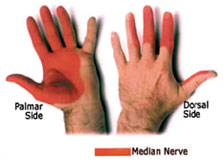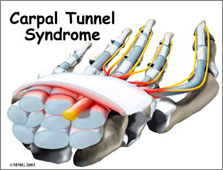Carpal Tunnel Syndrome
What Is CTS?

Carpal Tunnel Syndrome
CTS is a problem of the median nerve, which runs from the forearm into the hand. The median nerve provides sensation to the palm side of the thumb, index, and middle fingers and regulates the function of some small muscles in the hand that move the fingers and thumb. CTS occurs when the median nerve gets compressed in the carpal tunnel—a narrow tunnel at the wrist—made up of bones and soft tissues, such as nerves, tendons, ligaments, and blood vessels. The compression may result in pain, weakness, and/or numbness in the hand and wrist, which radiates up into the forearm. CTS is the most common of the “entrapment neuropathies”—compression or trauma of the body’s nerves in the hands or feet.
What Are the Symptoms?

Carpal Tunnel Syndrome
Symptoms usually begin gradually. Burning, tingling, itching, and/or numbness in the palm of the hand and thumb, index, and middle fingers are most common. Some people with CTS say that their fingers feel useless and swollen, even though little or no swelling is apparent. Since many people sleep with flexed wrists, the symptoms often first appear while sleeping. When this happens, some people feel the need to “shake off the numbness.” As symptoms worsen, people may feel tingling during the day. In addition, weakened grip strength may make it difficult to form a fist, grasp small objects, or perform other manual tasks. Some people develop wasting of the muscles at the base of the thumb. Some are unable to distinguish hot from cold by touch.
Why Does CTS Develop?
Some people have smaller carpal tunnels than others, which makes the median nerve compression more likely. In others, CTS can develop because of an injury to the wrist that causes swelling, over-activity of the pituitary gland, hypothyroidism, diabetes, inflammatory arthritis, mechanical problems in the wrist joint, poor work ergonomics, repeated use of vibrating hand tools, and fluid retention during pregnancy or menopause. In some cases, no cause can be identified.
How Is It Diagnosed?
 To avoid permanent damage to the median nerve, CTS should be diagnosed and treated early. A standard physical examination of the hands, arms, shoulders, and neck can help determine if your symptoms are related to daily activities or to an underlying disorder. The doctors at Gateway Chiropractic are well versed at properly diagnosing and treating CTS.
To avoid permanent damage to the median nerve, CTS should be diagnosed and treated early. A standard physical examination of the hands, arms, shoulders, and neck can help determine if your symptoms are related to daily activities or to an underlying disorder. The doctors at Gateway Chiropractic are well versed at properly diagnosing and treating CTS.
What Is the CTS Treatment?
CTS treatment should begin as early as possible under a doctor’s supervision. Initial therapy includes:
- Resting the affected hand and wrist
- Avoiding activities that may worsen symptoms
- Immobilizing the wrist in a splint to avoid further damage from twisting or bending
- Cool packs to help reduce swelling from inflammations
- Chiropractic joint manipulation and mobilization of the wrist and hand, stretching and strengthening exercises and soft-tissue mobilization techniques can be helpful. Occasionally, patients whose symptoms fail to respond to conservative care may require surgery.
How Can CTS Be Prevented?
- Perform on-the-job conditioning, such as stretching and light exercises. Take frequent rest breaks.
- Wear splints to help keep the wrists straight.
- Use fingerless gloves to help keep the hands warm and flexible.
- Use correct posture and wrist position to help prevent CTS.
- The doctors at Gateway Chiropractic can help educate your employer about CTS. To minimize workplace injuries, jobs can be rotated among workers. Employers can also develop programs in ergonomics—the process of adapting workplace conditions and job demands to workers’ physical capabilities.